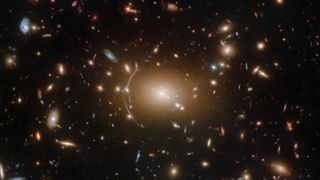Hubble telescope spies a cosmic 'spider web' containing clues to dark secret
A spooky image of a "cosmic cobweb" of galaxies is clustering in a way that confounds scientists.

A spooky image of a "cosmic cobweb" of galaxies is clustering in a way that confounds scientists.
The eerie Hubble Space Telescope image was released for the "spooky season" surrounding Halloween, according to an Oct. 27 statement from officials at the European Space Agency. What astronomers are spying could contain clues about dark matter, a mysterious substance that looms in an estimated 85 percent of the known universe.
Abell 611 is located roughly 3.2 billion light years from Earth and confuses astronomers, officials noted, as the whirling galaxies do not contain enough visible mass "to prevent the cluster from flying apart." The galaxy cluster likely is held together by dark matter, which scientists are struggling to understand because the substance cannot be sensed with conventional instruments.
Related: Advanced AI discovers a treasure trove of gravitational lenses
Dark matter theories cluster into one of two groups, ESA officials stated. It is either, they wrote, "some type of particle that exists in vast quantities throughout the universe — but for some reason does not interact with light as other particles do — or some type of massive object that […] does not lend itself to detection using current telescope technology."
Dark matter is evident in this cluster, ESA officials added, due to a phenomenon known as gravitational lensing. The massive gravity of Abell 611 bends the light of more distant objects in behind, allowing astronomers to catch a glimpse of faraway galaxies.
"An example of lensing is perhaps most clearly visible in the center of the image, to the left of the cluster’s glowing core, where a curve of light can be seen," officials wrote.
Get the Space.com Newsletter
Breaking space news, the latest updates on rocket launches, skywatching events and more!
While huge clusters like Abell 611 allow scientists to peek at otherwise invisible galaxies in the distance, on a smaller scale gravitational lensing can even be used to study stars or planets.
For example, a separate study released in May suggests we could use the sun's gravitational field to seek life on faraway exoplanets. Also, the newly operational James Webb Space Telescope used gravitational lensing of a galaxy to spot the most distant known star yet, nicknamed Earendel, shortly after Hubble saw the old star for the very first time.
Launched in 1990, the Hubble Space Telescope is an ongoing collaboration between NASA and the European Space Agency. This latest image was taken as part of four different observation programs studying the large scale structure of the universe, the structure and evolution of galaxies and gravitational lensing.
Follow us on Twitter @Spacedotcom or on Facebook.
Join our Space Forums to keep talking space on the latest missions, night sky and more! And if you have a news tip, correction or comment, let us know at: community@space.com.

Andrew is a freelance space journalist with a focus on reporting on China's rapidly growing space sector. He began writing for Space.com in 2019 and writes for SpaceNews, IEEE Spectrum, National Geographic, Sky & Telescope, New Scientist and others. Andrew first caught the space bug when, as a youngster, he saw Voyager images of other worlds in our solar system for the first time. Away from space, Andrew enjoys trail running in the forests of Finland. You can follow him on Twitter @AJ_FI.
Most Popular


